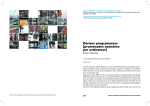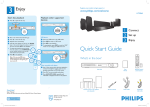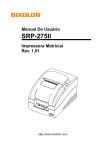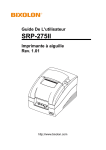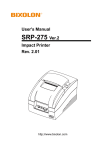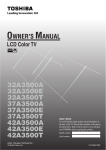Download Toshiba 32AV800 LCD TV
Transcript
OWNER’S MANUAL LCD COLOUR TV 32AV800E 32AV800V 32AV800T © 2011 TOSHIBA CORPORATION All Rights Reserved English Contents Introduction...................................................................................................................................... 3 Welcome to Toshiba .................................................................................................................. 3 Important Safety Instructions ...............................................................................................................................3 Important information.................................................................................................................. 7 Getting started ................................................................................................................................. 8 TV front and side panel controls ..........................................................................................................................9 TV back panel connections ...............................................................................................................................10 Learning about the remote control.....................................................................................................................11 Turning the TV on ..............................................................................................................................................12 Learning about the menu system ......................................................................................................................12 Watching TV Programmes ................................................................................................................................13 Programming channels into the TV’s channel memory .....................................................................................14 Using the TV’s features (General) ................................................................................................ 15 Picture adjustment.............................................................................................................................................15 Available Picture Size and Position Control ......................................................................................................15 Sound adjustment..............................................................................................................................................16 Other features settings ......................................................................................................................................17 Selecting the video input source to view ........................................................................................................... 19 Teletext Languages ...........................................................................................................................................19 Connecting your TV .................................................................................................................. 21 Side and back connections................................................................................................................................21 Connecting a computer .....................................................................................................................................23 Acceptable Video signals through HDMI terminals ...........................................................................................24 Acceptable PC signals through HDMI/D-SUB terminals ................................................................................24 Using the PC Setting .........................................................................................................................................25 Reference section.......................................................................................................................... 26 Troubleshooting .................................................................................................................................................26 Broadcast system ..............................................................................................................................................27 .................................................................................................................................................... 28 2 English Introduction Welcome to Toshiba About the fuse • Thank you for purchasing this Toshiba LCD Colour TV. This manual will help you use the exciting features of your new TV. In a three pin earthing-type, the fuse fitted in this plug is approved by ASTA or BSI to BS1362. It should be only be replaced by a correctly rated and approved type and the fuse cover must be refitted. • Instructions in this manual are based on using the remote control. • You also can use the controls on the TV if they have the same name as those referred to on the remote control. • Please read all safety and operating instructions in this manual carefully, and keep this manual for future reference. Important Safety Instructions Be sure to observe the following instructions and precautions to ensure safe use of this TV. Installation 1) Always connect the power plug to an appropriate electrical outlet equipped with ~110-240V, 50/60Hz. About the earth An appliance with protective earth terminal should be connected to a mains outlet with a protective earth connection. About the use • Make sure to insert the plugs firmly, when plugging the AC power cord into the TV set end and wall outlet end. • Make sure to hold the plug, when unplugging the AC power cord. • Never use other cord except for supplied AC power cord, and never use the supplied power cord for any other purpose. 2) Never insert or remove the power plug with wet hands. This may cause an electric shock. Never use the TV outside the specified voltage range. It may cause a fire or an electric shock. ~110-240V, 50/60Hz WARNING ABOUT THREE-WIRE GROUNDING-TYPE PLUG • This product shall be connected to a main socket outlet with a protective earthing connection. • Never remove the earthing pin on the power plug. This system is equipped with a three pin earthing-type power plug. This plug will only fit an earthing-type power outlet. This is a safety feature. If you are unable to insert the plug into the outlet, contact an electrician to replace the wall outlet. 3) Never place the TV in an unstabilized location such as on a shaky table, incline or location subject to vibration. • Only use cabinets or stands recommended by the TV manufacturer. • Only use furniture that can safely support the TV. • Ensure that the TV is not hanging over the edge of the supporting furniture. • Never place the TV on tall furniture (for example, cupboards or bookcases) without anchoring both the furniture and the TV to a suitable support. The TV may drop or fall off, which may cause an injury or damage. • Never defeat the purpose of the earthing plug. 3 English Introduction 4) Never block or cover the slots and openings in the cabinet. • Never place the TV so that it is facing upward or on its side. • Never place the TV in a closet, bookcase or other similar area where the ventilation is poor. • Never drape a newspaper, tablecloth or curtain on the TV. • Never stand the TV on cloth or other material placed between the TV and supporting furniture. • When installing the TV against a wall, always keep the TV at least 10 cm away from the wall. • Never place the TV on a soft unstable surface, such as a carpet, or a cushion. The inside of this TV will overheat if the ventilation holes are covered, blocked or sealed, which may result in a fire. 8) Locate the television away from direct sunlight or other strong lights. Soft, indirect lighting is recommended for comfortable viewing. Use curtains or blinds to prevent direct sunlight falling on the screen. Place the TV set on a stable, level surface that can support the weight of the TV. In order to maintain stability and prevent it from falling over, secure the TV to the level surface using the strap located under the table top stand, or to a wall using a sturdy tie to the clip on the back of the table top stand. The LCD display panels are manufactured using an extremely high level of precision technology, however sometimes some parts of the screen may be missing picture elements or have luminous spots. This is not a sign of a malfunction. Make sure the television is located in a position where it cannot be pushed or hit by objects, as pressure will break or damage the screen, and that small items cannot be inserted into slots or openings in the case. 5) Never place the TV near a heater or in direct sunlight. The surface of the cabinet or power cord may melt and result in a fire or an electric shock. Sturdy strap (as short as possible) 4" min. TV side v iew 6) Never place the TV in an area exposed to high humidity levels, such as in a bathroom or close to a humidifier. This may cause a fire or an electric shock. 7) Never place the TV next to a stove where it will be exposed to oil, smoke, or steam, or in a location where there is a large quantity of dust. This may cause a fire or an electric shock. 4 Hook TV top v iew ! "# • Purchase a VESA compatible wall bracket: VESA 200x200/ M6 screws/ 8mm/ 20kg. • Locate your ideal TV position on the wall. • Fix the wall bracket firmly on the wall. English Introduction Use 1) sources, such as lighted candles or nightlights, on or close to the TV. High temperatures can melt plastic and lead to fires. • Secure the TV to the bracket using the 4 mount screws on the back and the centre of the TV. 2) The apparatus shall not be exposed to dripping or splashing and that no objectsled with liquids, such as vases, shall be placed on the apparatus. For instruction purposes only $%& "'# • When moving the TV, be sure to remove the plug from the wall outlet and disconnect the aerial cable and audio/video cables, any steady ties. A fire or an electric shock may result if the power cord is damaged. • When carrying the TV, at least two people are needed. Be sure to carry it upright. • Never carry the TV with the screen facing up or down. 11) Precautions for installing on outdoor aerial An outside aerial system should not be located in the vicinity of overhead power lines, or other electric light or power circuits. If the aerial falls down or drops, it may cause an injury or an electric shock. When liquids are spilled or small items are dropped inside the TV, this may cause a fire or an electric shock. If small objects drop inside the TV, turn off the TV and remove the power plug from the outlet immediately and contact a service technician. pour water inside the TV through ventilation holes and other openings. These items may cause a fire or an electric shock. If these objects are inserted inside the TV, turn off the TV and remove the power plug from the outlet immediately and contact a service technician. Be especially careful that children do not insert objects in the TV. Clip • Educate children about the dangers of climbing on furniture to reach the TV or its controls. Be especially careful in households with children to prevent them through climbing on top of the TV. It may move, fall over, break, become damaged or cause an injury. 5 English Introduction 5) When the TV will not be used for a long period of time, such as during vacation or travel, remove the power plug from the wall outlet for safety. • The TV is not completely disconnected from the power supply line, as minute current is consumed even when the Power switch is turned off. Service 1) Never repair, modify or disassemble the TV by yourself. It may cause a fire or an electric shock. Consult a service technician for inspection and repairs. • The Mains plug or an appliance coupler is used as the disconnect device, therefore the disconnect device shall remain readily operable. 2) When a malfunction occurs, or if smoke or an unusual odor comes from the TV, turn off the TV and remove the power plug from the outlet immediately. 6) Never pull on the power cord when removing the plug from the wall outlet. Always hold the plug firmly when removing it. If the power cord is yanked, the cord may become damaged and a fire or an electric shock may occur. 7) Never cut, break, modify, twist, bunch up or bent the cord or apply excessive force or tension to it. Never place heavy objects on the cord or allow it to overheat as this may cause damage, fire or an electric shock. Contact a service technician if the power cord is damaged. 8) If there is thunder or lightning, never touch the aerial cable or other connected cables. You may suffer an electric shock. 6 Make sure that the smoke or smell has stopped, then contact a service technician. If the TV is still used in this condition, it may cause a fire or an electric shock. 3) If the TV is dropped or the cabinet is broken, turn off the TV and remove the power plug from the outlet immediately. If the TV has power in this condition, it may cause a fire or an electric shock. If the cabinet is broken, be careful when handling the TV to prevent an injury. Contact a service technician for inspection and repair. 4) When the TV reaches the end of its useful life, ask a qualified service technician to properly dispose of the TV. Note: The lamp unit contains a small amount of mercury. Disposal of mercury may be regulated due to environmental considerations. Dispose of the used lamp unit by the approved method for your area. For disposal or recycling information, please contact your local authorities. Cleaning English Introduction 3) Some pixels of the screen do not light up 1) Remove the power plug before cleaning. Never use solvents such as benzine or thinner to clean the TV. • These solvents may distort the cabinet or damage its finish. • If rubber or vinyl products remain in contact with the TV for a long time, a stain may result. If the cabinet becomes dirty, clean it with a soft, dry cloth. When cleaning the surface of the LCD display, wipe the panel surface gently with a soft, dry cloth. The LCD display panel is manufactured using an extremely high level of precision technology, however sometimes some pixels of the screen may be missing picture elements or have luminous spots. This is not sign of malfunction. 4) About interference The LCD display may cause interference in image, sound, etc. of other electronic equipment that receives electromagnetic waves (Ex. AM radios and video equipment). 5) About using under the low temperature places If you use the TV in the room of 0°C or less, the picture brightness may vary until the LCD monitor warms up. This is not a sign of a malfunction. 6) About afterimage 2) Periodically disconnect the power plug from the outlet and check it. If dust has collected on the power plug connectors, clean off the dust with a dry cloth. This dust may cause a fire due to reduced insulation on the plug. Clean here Important information 1) About LCD screen • If you have the LCD screen facing to the sun, the LCD screen will be damaged. Be aware of locating the TV close to a window or outdoors. • Never press the LCD screen strongly or scratch it, and never put anything on it. These actions will damage the LCD screen. 2) About cabinet and LCD screen Never spray volatile compounds such as insecticide on the cabinet and LCD screen. This may cause a discolouration or damage the cabinet and LCD screen. If a still picture is displayed, an afterimage may remain on the screen, however it will disappear. This is not a sign of malfunction. Exemptions • Toshiba is not liable for any damage caused by fires, natural disaster (such as thunder, earthquake, etc.), acts by third parties, accidents, owner’s misuse, or uses in other improper conditions. • Toshiba is not liable for incidental damages (such as profit loss or interruption in business, modification or erasure of record data, etc.) caused by use or inability to use of product. • Toshiba is not liable for any damage caused by neglect of the instructions described in the owner’s manual. • Toshiba is not liable for any damage caused by misuse or malfunction through simultaneous use of this product and the connected equipment. Trademark Information • HDMI, the HDMI logo, and High-Definition Multimedia Interface are trademarks of HDMI Licensing LLC. 7 English Getting started Connecting an aerial Exploring your new TV Optimum reception of colour requires a good signal and will generally mean that an outdoor aerial must be used. Installing the remote control batteries The exact type and positioning of the aerial will depend upon your particular area. Insert two R03 (AAA), 1.5V batteries matching the –/+ polarities of the battery to the –/+ marks inside the battery compartment. Remove the battery cover. Your Toshiba dealer or service personnel can best advise you on which aerial to use in your area. Before connecting the aerial cable, turn off all main power switches. Connect the cable TV or outdoor aerial to the ANALOGUE CABLE (75Ω) terminal to receive the analogue TV system signal. 32AV800E/32AV800T/32AV800V TV back view Cautions: • Dispose of batteries in a designated disposal area. Batteries must not be exposed to excessive heat such as sunshine, fire or the like. • Attention should be drawn to the environmental aspects of battery disposal. Always dispose of batteries in accordance with applicable laws and regulations. • Never mix battery types or combine used batteries with new ones. Note: From cable TV or outdoor aerial (ANALOGUE CABLE) • If the remote control does not operate correctly, or if the operating range becomes reduced, replace both batteries with new ones. • If the batteries are dead or if you will not use the remote control for a long time, remove the batteries to prevent battery acid from leaking into the battery compartment. Effective range within 5m 8 English Getting started TV front and side panel controls • You can operate your TV using the buttons on the side panel or the remote control. The back and side of the panel provide the terminal connections to connect other equipment to your TV ( “Connecting your TV” pages 21 – 25 ). • For the use of each control, see the pages in brackets. 1 Remote sensor — Point the remote control toward this remote sensor ( “Remote control effective range” on page 8). 2 (Power LED) — Power LED (Green/ Red) = Power indicator 3 (Input) — Repeatedly press to change the source you are viewing (TV, AV1, AV2, YPBPR, HDMI, VGA). 4 MENU (EXIT) — Press to access the menu system ( pages 12 – 13 ). When a menu is on-screen, the MENU button on the TV’s control panel functions as the EXIT button. 5 6 (Programme position) — When no menu is on-screen, these buttons select the programme position ( page 13). + - (Volume) — These buttons adjust the volume level. 7 (POWER) — Press to turn the TV on and off.If the TV stops responding to the controls on the remote control or TV control panel and you cannot turn off the TV, unplug the power cord until the power LED extinguished, and then plugin the power cord again to reset the TV. 8 Headphone jack — For use with headphones. 9 AV2 (VIDEO) — Standard (composite) video and standard audio inputs plus with composite video . 9 English Getting started TV back panel connections 32AV800E/32AV800T/32AV800V AV AUDIO IN AV VIDEO IN 10 English Getting started Learning about the remote control Location of controls In TV and AV1/2 mode: Display current channel information normal picture 11 English Getting started Turning the TV on Learning about the menu system Switching on the TV We suggest you familiarize yourself with the display charts before using the menu system: Connect the power cord to a wall outlet, the power indicator lights in red (standby mode). on the TV right Press on the remote control or side panel, the power indicator lights in green. Note: If you watch black and white programmes when the colour system mode is set to Auto, colour noise may appear on the screen. In this case select the appropriate Colour system (For the system, refer to page 18). • Press MENU to display menu, then press or to select main menu headings. • Press or to select an item. • Press or to select or adjust setting. • Press to display the next menu. OK Displaying the TV MENU chart PICTURE menu Switching off the TV Press on the remote control or on the TV right side panel to switch to the standby mode. Note: • When the TV will not be used for a long period of time, such as during vacation or travel, remove the power plug from the wall outlet. • If power is cut off while you are viewing the TV, the Last Mode Memory function turns on the TV automatically when power is applied again. If power is going to be off for a long time and you are going to be away from your TV, unplug the power cord to prevent the TV from turning on in your absence. Using the Quick Setup (TV Only) PICTURE Picture Mode PICTURE User Picture Mode 50 Brightness 50 Contrast Saturation 50 50 Contrast Saturation 50 50 Tint 50 Tint 50 50 Sharpness Backlight Colour Temp. 50 Standard 16:9 Picture Size Adjust 50 Sharpness Backlight ColoUr Temp. 50 Standard 16:9 Picture Size Select Exit EXIT Adjust Select Exit EXIT SOUND menu SOUND Sound Mode SOUND Standard Sound Mode Equalizer Balance 0 Auto Volume Off MTS Balance 0 Off Auto Volume MTS Mono Adjust Standard Equalizer Select Exit EXIT Mono Adjust Select Exit EXIT SET UP menu SET UP Quick Setup helps you quickly select the desired language and start the automatic search. User Brightness Language SET UP English Language Screen Saver Off Screen Saver DNR On DNR On DLC DLC Teletext Adjust Off On On Teletext East European Reset The Quick Setup window appears when the TV is turned on for the first time or after resetting. English East European Reset Select EXIT Exit Adjust Select Exit EXIT TIMER menu Quick Setup Select your language. TIMER Language OK 1 2 Next OK Off No Signal Sleep Off Sleep Timer Off Sleep Timer Off English Select Press or to select the desired language. Press TIMER No Signal Sleep to start auto tuning. Adjust Select EXIT Exit Adjust Select EXIT Exit CHANNEL menu Auto Tuning CHANNEL Channel CHANNEL 1 Channel Auto Color System Auto Sound System Auto Sound System Auto Skip Off Fine Tune Skip 63.25MHZ Off Fine Tune Auto Tuning Auto Tuning Manual Tuning Manual Tuning Swap Adjust 12 1 Color System 63.25MHZ Swap Select EXIT Exit Adjust Select EXIT Exit Note: • In the video input mode, Auto Tuning and Manual Tuning are not available. • If you do not make a selection for a while, the menu display disappears automatically. • If you want to close the menu display instantly, press EXIT or MENU. • To return to the previous menu, press RETURN. Changing the position 1 Enter the desired position number using the Number buttons on the remote control. For positions below 10, use 0 and the requiring number. Ex., for position 1. 16 2 Watching TV Programmes Selecting the menu language Choose from different languages (English, Chinese, Malayu, Thai, Vietnamese, Russian, Arabic, Farsi and Francais) for the On-Screen Display. English Getting started You can also change the position by using or P . P The position will be displayed on the screen with the Mono/Stereo/Nicam audio status. Note: Changing positions between different format channels will takes several seconds. Displaying the on-screen information 1 Press MENU, then press or to display the SET UP menu. 1 Press to display the following on-screen information. SET UP Language 13 English Screen Saver Off DNR On DLC On Teletext East European The information will disappear in about 5 seconds. Reset Adjust 2 3 Select EXIT • Position or external input mode selected Exit Press or to select Language. • Mono/Stereo/Nicam audio status Press or to select the desired language. 2 To erase the display instantly, press EXIT. 13 English Getting started Programming channels into the TV’s channel memory Auto tuning 1 From the CHANNEL menu, press or to select Auto Tuning. Channel Auto Sound System Auto 63.25MHZ Auto Tuning Manual Tuning Swap Select EXIT Exit Press or to start the automatic search. CH: 1 77.25MHZ 3 When the automatic search is completed, the TV will automatically return to programme position 1. 4 Closing the Auto Tuning menu, press EXIT. The search will begin for all available stations. The slide bar will move along the line as the search progresses. You must allow the television to complete the search. When the search is complete the television will automatically select programme position 1. This may not be a clear picture or the signal may be weak, so the station order can be changed using Manual tuning in CHANNEL menu. 14 2 Press or to enter Manual Tuning menu , then press button to search from low frenquency to high, or 0DQXDO7XQLQJ Off Fine Tune Auto Tuning From the CHANNEL menu, press or to select Manual Tuning. 1 Color System Skip 2 1 button to search from high to low. CHANNEL Adjust Manual tuning CH: 1 77.25MHZ English Picture adjustment Available Picture Size and Position Control Selecting the picture size Press MENU b utton o n th e rem ote co ntrol, th en press / bu tton to selec t PICTURE menu. n Screen Mode 16:9 PICTURE Picture Mode 4:3 User Brightness 50 Contrast Saturation 50 50 Tint 50 Sharpness 50 Backlight Colour Temp. Adjust d 50 Standard Select Size PC H Yes V Yes H Yes V Yes a t S Adjusting the picture settings PC n Adjustment to the position of the picture may be made to suit your viewing preferences. 16:9 Picture Size English Using the TV’s features (General) EXIT Exit 1 Press / button to select Picture Size, and press / button to adjust picture mode to your desire. Press MENU, then press or to display the PICTURE menu. PICTURE Picture Mode 16:9 Use this setting when watching a widescreen DVD, widescreen video tape or a 16:9 broadcast (when available). 50 Contrast 50 Backlight Colour Temp. 50 Warm Picture Size Adjust 4:3 Use this setting to view a true 4:3 broadcast. User Brightness 16:9 Select EXIT Exit 2 Press or to select the item you want to adjust. 3 Press or to adjust the settings as desired. Note: If you use this function except for the purpose of your private viewing and listening, it may infringe the copyright protected by the copyright laws. 15 English Using the TV’s features (General) a t S Adjusting the Picture Mode Activating the picture preferences This TV offers the choice of personalising the picture style. You can customise current picture mode settings while selecting User. Standard, Dynamic, Mild and User are preset options and affect may features/settings within the TV. 1 1 From the PICTURE menu press or to select Picture Mode. From the PICTURE menu press or to select either Brightness , Contrast , Saturation , Tint, Sharpness , Backlight or Colour Temperature . PICTURE PICTURE Picture Mode Picture Mode User User Brightness 50 Contrast Saturation 50 50 Tint 50 Brightness 50 Contrast Saturation 50 50 Tint 50 Sharpness 50 Sharpness 50 Backlight Colour Temp. 50 Backlight Colour Temp. 50 Standard 16:9 Picture Size Standard 16:9 Picture Size Adjust Adjust 2 Select EXIT Select EXIT Exit Exit Press or to select the picture mode you want. Sound adjustment 1 Press MENU, and then press or to display the SOUND menu. SOUND Sound Mode Standard Equalizer Balance 0 Off Auto Volume MTS Mono Adjust 2 16 Select EXIT Exit Ad ju sting S oun d Mo de Press / button to select Sound Mode , use / butto n to adjust so u n d m o d e:Standard, News, Music and User. English 3 English Using the TV’s features (General) A dju stin g E qualizer Other features settings Setting the Set Up menu Press / bu tto n to select Equalizer , an d press / bu tto n to enter sub menu , press / b utto n to select a c irtain fren qu en cy, and u se / b utto n to adju st its value. MENU SET UP menu. SET UP SOUND 120Hz Language 50 500Hz 50 1.5KHz 50 5KHz 50 10KHz 50 English Screen Saver Off DNR On DLC On Teletext East European Reset Adjust 4 Select EXIT Exit A dju sting Balanc e o f so un d Press / b u tto n to select Balance, use / b u tto n to adju st so u n d b alan ce. 5 1 2 Adju st Auto Volume Press / bu tton to select Auto Volume , use / b utto n to select On or Off 6 Adjust Adjust MTS of so und Press / b utto n to selec t MTS, use / bu tton to ad ju st to yo ur d esired . 3 Select EXIT Exit Press button to select Screen Saver and press button to select Off or Blue. Press / button to select DNR Press / button to adjust DNR option, it can improve the picture sharpness. Note: DNR is only avarilable in TV,AV, YPBPR mode. Press / button to select DLC Press / button to adjust DLC DLC is to automatically detect distribution of inputted visual signal and adjust to create optimum luminance. 4 Press / button to select Reset Press button to Reset TV data. 17 English English Using the TV’s features (General) Setting the manual setting menu Setting the TIMER menu Press MENU then press / button to selec t TIMER m enu . Press MENU, then press or to display the CHANNEL menu. CHANNEL Channel TIMER No Signal Sleep Off Sleep Timer Off 1 Color System Auto Sound System Auto Skip Off Fine Tune 63.25MHZ Auto Tuning Manual Tuning Swap Adjust Adjust Select EXIT Exit 1 Press / button to select No Signal Sleep , and press / to select EXIT Exit 1 Press / b utto n to select C hannel yo u can see the curren t ch an nel n u m b e r. 2 On or Off. 2 Select P ress / bu tto n to select Color S ystem and then press / bu tto n to ch an ge vid eo fo rm at as follo ws: Auto Press / button to select Sleep Timer. NTSC You can start a sleep timer by setting Sleep Timer a preset time: 15Min, 30Min, 45Min, 60Min, 90Min, 120Min, when the time has passed, the TV will turn to standby mode automatically. If you select Off, the timer doesn’t work. 3 Press / b utto n to select S ound System , th en p ress / b utto n to selec t so u n d system as fo llo w s: Auto 4 Press / bu tton to select M Skip, then press / button to select On or Off. 5 In case of bad im age o r so und o f TV prog ram, you can use F in e Tu ne fu nc tion to ob tain satisfyin g im ag e o r so u n d with o p eratin g step s as fo llo w s: Press / bu tton to select Fine Tune and p ress / bu tto n to con d u c t fin e tu n in g fro m h ig h freq u en c y to lo w freq u en cy o r fro m lo w freq u en c y to high freq uenc y till best p icture o r so un d effec t is ob tain ed . 18 English 6 From the CHANNEL menu, press or to select Swap, and press / b utton to enter submenu. Current Channel, Target Channel and Exchange are used to swap two programs' numbers. CHANNEL Current Channel 1 Target Channel 1 English Using the TV’s features (General) Teletext Languages To select a language for teletext: 1 Press MENU, then press or to display the SET UP menu. 2 Press or to select Teletext Language, then press or to select the required language. Exchange SET UP Language English Screen Saver Off DNR On DLC On Teletext Adjust A B C Select EXIT Exit Cu rren t C han ne l Press / b utto n to ad just current ch an nel n um ber. Targ et C h an n el Press / bu tton to adjust target c ha nn el nu mb er. E xch ang e Press / bu tton to p erfo rm th e exch an ge of c ha nn el nu mb er. Selecting the video input source to view 1 Press on the remote control until the video input mode list appears on the to select screen, then press , or on appropriate input source (or press the TV right side panel to select required input source directly). Source TV AV1 AV2 East European Reset Adjust Select EXIT Exit • West European: English, German, Swedish,Finnish, Hungarian, Italian,French,Portuguese,Spanish, Turkish,Greek • East European: Polish, German, Estonian,Lettish, Lithuanian, French,Serbian,Croatian,Slovenian,Czech, Slovak, Rumanian • Russian: English,German,Estonian,Lettish, Lithuanian,Russian,Bulgarian,Ukrainian,Czech, Slovak • Arabic: English, German, Swedish, Finnish, Arabic Hungarian, Italian, French, Hebrew, Tukish, • Farsi: English,German,Swdeish,Finnish,Hungarian, Italian,French,Hebrew,Turkish,Farsi YPBPR HDMI VGA 2 Press . Note: When the component video input, PC input mode or HDMI input mode is selected, the HEADPHONE output terminals output analogue audio signal only. Note: • When you are watching the teletext programme, MENU button can’t selectable. • If there is no Teletext function on the channel than it will show No Teletext message in the center of the screen. 19 English Using the TV’s features (General) Using Subtitles 1 Press on the remote control to display the current Subtitle status. While this status is displayed, press again to change the setting. Note: If Subtitle is On, the TV will always display subtitles whenever such information is available for the channel you are viewing. Teletext buttons on the remote control Below is an introduction to the teletext buttons on your remote control and their functions. To display a page of teletext: to display teletext. Press again Press to superimpose the teletext over a normal broadcast picture. Press again to return to normal TV mode. To display on-screen information To reveal concealed text: Some pages cover topics such as quizzes and . jokes. To discover the solutions, press To hold a wanted page: broadcast teletext system but you will not need it as this TV allows you to control the display of sub-pages. To enlarge the teletext display size: Press once to enlarge the top half of the page, press again to enlarge the bottom half of the page. Press again to revert to the normal size. To select a page while viewing a normal picture: When in teletext mode, if a page selection is made and then is pressed, a normal picture will be displayed. The TV will indicate when the page is present by displaying the title bar of the to text page at the top of the screen. Press view the page. Note: It will not be possible to change programme position while in Teletext mode, you will have to cancel the teletext first by pressing to return to a normal TV picture. 20 English English Connecting your TV Side and back connections Please always refer to the owner’s manual of the equipment to be connected for full details. Connection examples: / Video Games • Before connecting any external equipment, turn off all main power switches. until the • To select desired input, press input list appears on the screen. Press or to make the selection, and then press OK . • If you connect monaural sound equipment to AV1/2 , connect the audio output of the equipment to the L/MONO jack on the TV. • You can enjoy Video Games with this TV. However shooting games, where the player shoots at a target on the TV screen with a light gun, may not work because of the LCD Colour TV properties. • The unauthorized recording of television programmes, DVDs, video tapes and other materials may infringe upon the provisions of copyright law. • The COMPONENT VIDEO INPUT consists of three component video signals (Y, PB/CB, PR/CR) and provides the best picture performance. These terminals can only be used with the component video compatible equipment, Ex. DVD video player, etc. Connecting an HDMI device • When turning on your electronic components, turn on the TV first, and then the HDMI device. • When turning off your electronic components, turn off the HDMI first, and then the TV. • This TV may not be compatible with features and/ or specifications that may be added in the future. • This TV is able to connect with HDMI devices. But it is possible that some HDMI devices may not operate properly with this TV. The HDMI input on your TV receives digital audio and uncompressed digital video from a HDMI device. This input is designed to accept HDCP programme material in digital from CEA-861-D compliant consumer electronic devices (such as a set top box or DVD player with HDMI output). • Additional equipment and cables shown are not supplied with this TV. 21 English The HDMI input is designed for best performance with 1080i (50/60 Hz) and 1080p (50/60 Hz) high-definition video signals, but will also accept and display 576i/ p, 720p (50Hz); 480i/p, 720p (60 Hz: except for E-EDID) signals. Please see “Acceptable Video signals through HDMI terminals“ on page 24. * HDMI: High-Definition Multimedia Interface * HDCP: High-bandwidth Digital Content Protection * CEA-861-D compliance covers the transmission of uncompressed digital video with high-bandwidth digital content protection, which is being standardized for reception of high-definition video signals. Because this is an evolving technology, it is possible that some devices may not operate properly with the TV. * E-EDID: Enhanced-Extended Display Identification * Acceptable PC signal format: please see “Acceptable PC signals through HDMI/DSUB terminals“ on page 24. However, these signal formats are converted to match the number of pixels of the LCD panel. Therefore, the TV may not display small text properly. If you connect this unit to your PC, the compressed image is displayed in S-XGA mode, therefore the picture quality may deteriorate and characters may not be read. 22 English Connecting your TV Connecting an HDMI device One HDMI cable (type A connector) TV back view HDMI device For proper operation, it is recommended that you use a short HDMI cable. HDMI cable transfers both video and audio. English Connecting a computer Signal names for mini D-sub 15 pin connector Pin assignment for RGB/PC terminal To connect a PC to the RGB/PC terminal on the TV: 5 10 15 An analogue RGB (15 pin) computer cable can be connected. Pin No. 1 2 3 4 TV back view Mini D-sub 15 pin 5 6 7 8 Computer RGB PC cable Conversion adapter (if necessary) English Connecting your TV 1 6 11 Signal name Pin No. R 9 G 10 B 11 NC (not 12 connected) NC 13 Ground 14 Ground 15 Ground Signal name NC Ground NC SDA H-sync V-sync SCL To connect a PC to the HDMI terminal on the TV: When connecting a PC to the HDMI terminal on the TV, use an HDMI to DVI adapter cable and analogue audio cables. Audio cable for PC-toTV connection Connect a PC cable from the computer to the PC IN terminal on the back of the TV. Note: • Some PC models cannot be connected to this TV. • There is no need to use an adapter for computers with DOS/V compatible mini D-sub 15 pin terminal. • A bar may appear in the upper, lower, right or left side of the screen, or parts of the picture may be obscured depending on some signals. This is not the malfunction. • If the edges of the picture are stretched, readjust the picture position adjustments in the PC Setting menu. • Depending on the specification of the PC you are playing the DVD-Video on, and the DVD’s title, some scenes may be skipped, or you may not be able to pause during multi-angle scenes. If connecting a PC with an HDMI terminal, use an HDMI cable (type A connector). Separate analogue audio cables are not necessary. TV back view TV back view For acceptable PC signal format ( page 24). Note: • The edges of the images may be hidden. • If connecting a certain PC model that signal is particular, the PC signal may not be detected correctly. 23 English English Connecting your TV Acceptable Video signals through HDMI terminals Format Resolution V. Frequency H. Frequency Pixel Clock Frequency 480i 720 x 480i 60Hz 15.734KHz 27MHz 480p 720 x 480p 60Hz 31.5KHz 27MHz / 27.027MHz 576i 720 x 576i 50Hz 15.625KHz 27MHz 576p 720 x 576p 50Hz 31.25KHz 54MHz 720p 1280 x 720p 50Hz 37.5KHz 74.25MHz 720p 1280 x 720p 59.94Hz / 60Hz 44.9KHz / 45KHz 74.17MHz / 74.25MHz 1080i 1920 x 1080i 50Hz 28.125KHz 74.25MHz 1080i 1920 x 1080i 59.94Hz / 60Hz 33.72KHz / 33.75KHz 74.17MHz / 74.25MHz 1080p 1920 x 1080p 50Hz 56.25KHz 148.5MHz 1080p 1920 x 1080p 59.94Hz / 60Hz 67.432KHz / 67.5KHz 148.35MHz / 148.5MHz Acceptable PC signals through HDMI-SUB terminals Format Resolution V. Frequency H. Frequency Pixel Clock Frequency VGA 640 x 480 59.9Hz 31.469KHz 25.175MHz SVGA 800 x 600 60.3Hz 37.879KHz 40MHz XGA 1024 x 768 60Hz 48.363KHz 65MHz WXGA 1280 x 768 59.9Hz 47.396KHz 68.25MHz WXGA 1280 x 768 59.8Hz 47.776KHz 79.5MHz WXGA 1360 x 768 60Hz 47.712KHz 85.5MHz SXGA 1280x1024 60Hz 63.981KHz 108MHz HDMI, the HDMI Logo, and High-Definition Multimedia Interface are trademarks or registered trademarks of HDMI Licensing LLC in the United States and other countries. Note 1 : HDMI terminal supports PC signal input. Note 2 : For PC input, for only supported PC signal can show the correct resolution on TV display. 2 English English Connecting your TV Using the PC Setting Adjusting the clock phase of the picture • This function may not be available for some signal or if no signal is received. If the clock phase, which synchronize the PC signal and LCD display, is not optimized, the picture will blur. • The optimum points of the clock phase and sampling clock adjustments may be incomprehensible according to the input signals. This function enables you to adjust clock phase and display a clear picture. Adjusting the picture position An analogue RGB (15 pin) computer cable can be connected. MENU then press or to display 1 Press the WINDOW menu. 2 Press or to select an option you want to adjust. Press or to adjust the settings as required. H-Position 100 V-Position 100 Clock 100 Phase 0 Auto Adjust Select From the WINDOW menu, press or to select Phase . 2 Press or to obtain a clear picture. Auto Adjust The Auto Adjust window appears when the PC signal is detected for the first time. Auto Adjust configures the Horizontal position, Vertical position, Sampling clock and Clock phase settings. From the WINDOW menu, press or to 1 select Auto Adjust. 2 WINDOW Adjust 1 EXIT Press . Note: Only “H-Position” and “V-Position” are available in the YPBPR mode. Exit WINDOW H-Position 100 V-Position 100 Adjusting the sampling clock If the sampling clock does not match with the dot clock frequency of the PC, blurred picture detail will occur, or screen width will change, or drift patterns in vertical lines may be apparent. Adjust Select EXIT Exit This function enables you to adjust it and optimize the picture. 1 From the WINDOW menu, press or to select Clock . 2 Press or to optimize the picture. 25 English Troubleshooting Before calling a service technician, please check the following table for a possible cause of the symptom and some solutions. Symptom and solution • When you just buy and start to use this TV, a flickering may be caused in the screen. In this case, switch off the TV, then switch on it again to cure the condition. • The cold cathode fluorescent lamp used for the back light on this TV has longevity. When the brightness of the screen comes down, or the flickers of the screen are caused, or some parts of the screen do not light up, it may reach the end of its life, contact a service technician. TV will not turn on • Make sure the power cord is plugged in, then press . • The remote control batteries may be dead. • Replace the batteries. Some pixels of the screen do not light up No picture, no sound • Check the aerial connections. No sound, picture OK • The sound may be muted. Press The brightness of the screen comes down, or flickers of the screen are caused, or some parts of the screen do not light up. +, − or • The station may have broadcast difficulties. Try another channel. Poor sound, picture OK • The station may have broadcast difficulties. Try another channel. Poor picture, sound OK • Check the aerial connections. • The station may have broadcast difficulties. Try another channel. • Adjust the PICTURE menu. . • The LCD display panel is manufactured using an extremely high level of precision technology, however, sometimes some pixels of the screen may be missing picture elements or have luminous spots. This is not a sign of a malfunction. The picture brightness varies when you switch the TV on. • If you switch the TV on at 0°C and under, wait until the warms up. Multiple images • The station may have broadcast difficulties. Try another channel. • Aerial reception may be poor. Use a high directional outdoor aerial. Poor reception of broadcast channels • Check if the direction of the aerial has changed. • Check the aerial connections. Poor colour or no colour • The station may have broadcast difficulties. Try another channel. • The station may have broadcast difficulties. Try another channel. • Mark sure the Colour System is properly set. • Adjust the Tint and/or Colour in the PICTURE menu. Teletext problems • Check the aerial connections. Good performance of text depends on a good strong broadcast signal. The remote control does not operate • Make sure the remote control is set to the correct device mode. • Remove all obstructions between the remote control and the remote control sensor on the TV. • The remote control batteries may be dead. Replace the batteries. 26 English Reference section English English Reference section Broadcast system Broadcast transmission systems of each country or region Asia M.E. Country or region Colour Sound Bahrain, Kuwait, Israel, Oman, Qatar, United Arab Emirates, Yemen, etc. PAL B/G China, Vietnam PAL D/K China Hong Kong PAL I Iraq, Islamic Republic of Iran, Lebanon, Saudi Arabia, etc. SECAM B/G Russian Federation, etc. SECAM D/K Myanmar, etc. NTSC M Country or region Colour Sound Australia, New Zealand, etc. PAL B/G Country or region Colour Sound Republic of South Africa, etc. PAL I Country or region Colour Sound Brazil PAL M Chile,Colombia, etc. NTSC M Indonesia, Malaysia, Singapore, Thailand, etc Oceania Africa South America Note: PAL, SECAM and NTSC 3.58 (MHz) are different colour signal broadcast transmission systems applicable to different countries or region. NTSC 4.43 (MHz) is used in special VCRs to playback NTSC recorded video tapes through PAL television equipment. 27 English Aspect ratio 16:9 LCD COLOUR TV Visible size English Reference section 32AV800*-80.0cm Model 32AV800E 32AV800T 32AV800V Number of pixels 1,366 (H) dots x 768 (V) dots Audio power Power source 110-240V, 50/60Hz 32AV800*- 5W + 5W Power consumption 32AV800*-120W Input/Output terminals AV1/2 Dimensions 32AV800*-56.5(H)cmx79.6cm(W)x23.0cm(D) Mass (Weight) YPBPR Television system (Aerial input) Channel coverage: VHF UHF CATV PAL I (UK) VHF UHF CATV PAL D/K (CHINA) VHF UHF CATV SECAM B/G (CCIR) VHF UHF CATV SECAM D/K (OIRT) VHF UHF CATV NTSC M (US) VHF UHF CATV B/G (CCIR) (JAPAN) VHF UHF CATV 2 - 12 21 - 69 X - Z+2, S1 - S41 21 - 69 1 - 12 13 - 57 Z1 - Z38 2 - 12 21 - 69 X - Z+2, S1 - S41 1 - 12 21 - 69 X1 - X19 2 - 13 14 - 69 A6 - A1, A - W, AA - ZZ, AAA, BBB 1 - 12 13 - 62 M1 - M10, S1- S41 Special RF signal: NTSC 4.43 colour system 5.5/6.0/6.5 MHz sound system PAL 60 Hz colour system 5.5/6.0/6.5 MHz sound system COMPONENT VIDEO INPUT terminals (the signal format) 576i, 576p, 720p, 1080i 50Hz, 480i, 480p, 720p, 1080i 60Hz (These signal formats are converted to match the number of pixels of the LCD panel.) 28 Input Component video Y, PB/CB,PR/CR Audio jacks L/Mono + R VGA Input Mini D-sub 15pin HDMI Input (AUDIO) NTSC M Video, L/Mono + R Analogue RGB 32AV800*-10.0kg PAL Input A/V 3.5 mm (Diameter) stereo HEADPHONE Output (AUDIO) 3.5 mm (Diameter) stereo AV OUT Output A/V Video, L/Mono + R Operating condition Temperature: 5oC - 35oC (41oF - 94oF) Humidity: 20% - 80% (non-condensing) Supplied accessories Remote Control (1) Batteries (AAA 1.5V) (2) Owner’s Manual(1) • Design and specifications are subject to change without notice. • Never service or refit the TV by yourself. It may expose you to a fire hazard or dangerous voltages.































